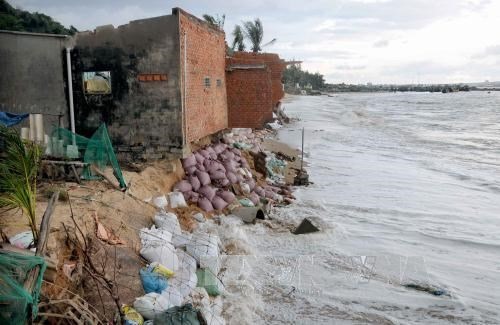Viet Nam News BÌNH THUẬN — Extreme weather conditions resulting in a complex tide phenomenon, landslides and sea erosion are threatening coastal areas in central Bình Thuận Province, authority officials and local people have said.
Mai Kiều, director of the provincial Department of Agriculture and Rural Development, said this week that landslides and erosion constantly hitting the province’s 10km coastline over the past 10 years had caused extensive damage to local life.
Tuy Phong District was the hardest hit area, with hundreds of households in the communes and townships, including La Gi, Tân Phước, Vĩnh Tân and Tiến Thành, faced with the high possibility of having to flee their homes.
Landslides and erosion have been increasingly impacting agricultural production; infrastructure, including roads and sea dykes; and particularly many protective forests.
The sea has completely destroyed over 450m of sea dykes and damaged nearly 300 houses and dozens of hectares of forest in the two areas of La Gi and Tân Phước alone, according to Kiều.
Last month, sea tides and waves 3-4m high devastated 150 households in Vĩnh Tân Commune, with some 300m of coastline completely eroded.
Since 2010, erosion has occurred along 800m of the coastline in Tiến Thanh Commune and Phan Thiết Town, affecting the lives of 46 local households.
For the last decade, many families in this southwestern province have been uprooted every year, Kiều said.
The official added it was not due to economic or political upheaval, but climate change that forcibly turned many of these coast-dwellers into unwilling travellers, as raging storms and a rising sea level led to continued loss of land – and homes.
Nguyễn Thị Kỷ, a resident in Tiến Thành Commune, said in the past several months, she and many others locals in the commune were struggling to deal with the erosion.
“Each household, rich or poor, if it wanted to remain in the area, had to pour more than VNĐ10 million (US$440) each into building a new embankment or rebuilding what was damaged by the high waves,” Kỷ said.
The poorest who could not afford such a huge sum of money had to evacuate, while those who wanted to stay had to prepare at least 100 bags of sand to set up a temporary fence to protect their houses, according to Kỷ.
“However, sometimes the sand bags could only protect the house for one day. If there were waves as high as 2-4m, they were all washed away,” an upset sounding Kỷ said.
Meanwhile, the Đất Lành tourism spot, which attracts thousands of tourists every year, has suffered continuous damage since 2015 due to high tides that destroyed more than 450m of sea embankment around the area.
Initial research from Bình Thuận’s Natural Resources and Environment Department revealed that in the past three years, the water had intruded some 3-4m inwards, along 2km of the coastline.
In some areas, research showed sea intrusion even reached between 30 and 60m over the past 10 years, such as the area in Tiến Thành Commune.
The research also revealed that along a total of 192km of coastline in the province, six point areas were found regularly suffering from the most serious landslides and erosion, and thus they needed urgent and special protection. Those areas included tourism resorts such as Hàm Tiến-Mũi Né, Liên Hương Town and Phan Rí Cửa living ward.
To cope with the situation, the province had built a total of 12km of sea dykes and embankment, with investment capital worth VNĐ1 trillion (US$44.3 million), including a 3km dyke along the Hàm Tiến-Mũi Né seashore where there are many tourism resorts, authority said.
The province had applied high technology imported from the Netherlands to build 1.6km of sea dyke at the Đồi Dương seashore in Phan Thiêt Town, but the project was interrupted due to damage from high waves during construction, according to the province’s People’s Committee.
Thus, the committee said the province had to change methods of construction by pouring more funds to build concrete dykes.
Committee’s vice chairman Phạm Văn Nam said the authortity had ordered all local authorities to coordinate with the province’s departments of agriculture and rural development, investment and planning to take immediate measures to help local people stabilise their life before Tết (Lunar New Year) and afterwards.
The province asked the two departments and local authorities to cooperate in building temporary sea dykes and consolidate damaged dyke sections in landslide-prone areas to ensure safety so locals could enjoy the Tết festival.
In the long term, the official requested the two departments to set up a plan to concretise all dyke system in the province, particularly sections around residential areas and tourism resorts.
Việt Nam, with a coastline stretching over 3,200km through 28 coastal provinces and cities, is one of the most vulnerable countries in the world to climate change.
The country determined that climate change is a serious challenge and to cope with this problem the Government has mobilised the participation of all sectors and conducted simultaneous adaptation and mitigation, in which adaptation is a priority, to actively prevent and avoid disasters.— VNS
 Society
Society






